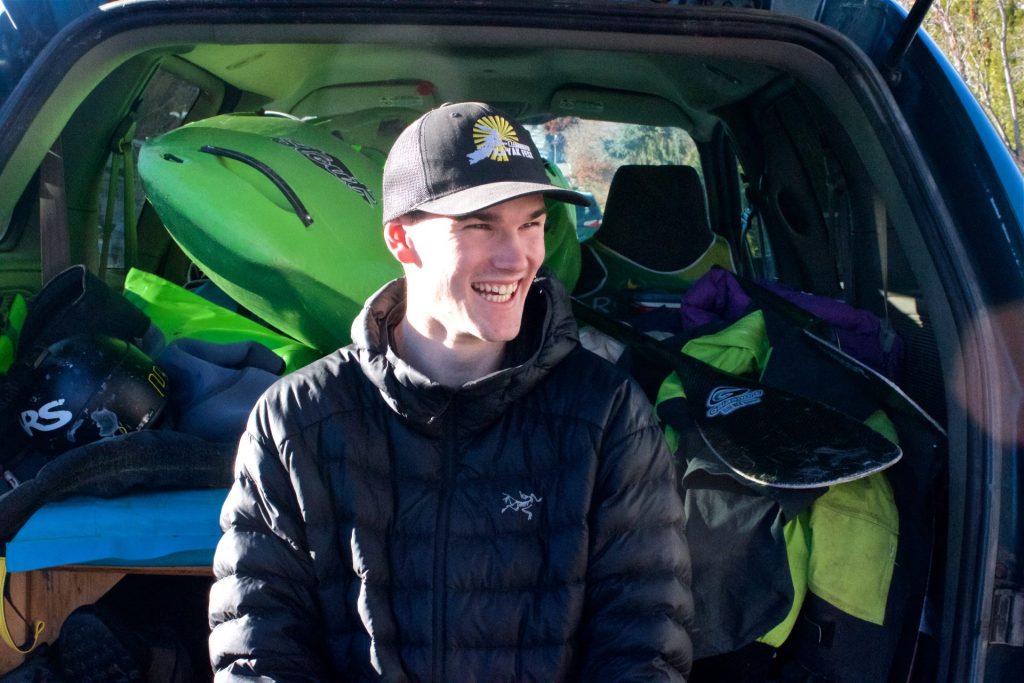Into the Azure
Photography: Pierce Huser, Oliver English, Dan Sutherland and Jeremy Nash
After a busy summer of west coast BC boating in 2021, I started talking with Cole Oruski, Oliver English, and Jeremy Nash about the idea of going into the Azure, a new classic multi day river in the Interior of BC. I took a look at the weather and found a 4 day window we could work with. This window being less than 4 days away, we had to get everything together and boost a 6 hour drive from Squamish to Clearwater asap. Before leaving I was hoping to add someone who was solid with rope skills in case we ended up in a funky situation, I called Dan “the man” Sutherland who was uber keen to come along. I loaded my Waka OG and started my pilgrimage back to Clearwater, super eager but nervous for the suffer fest I’d been hyping up to the boys.
The Azure has plenty of quality whitewater but the biggest challenge is undoubtedly getting to the river. A 10km hike in over a pass that consists of ultra thick bush will push even the strongest expedition kayakers to their limit. Stookesberry even said it was one of the most grueling hike-ins he’d ever done. The first half is the most challenging as it climbs 500m in elevation with no easy steps, but is rewarded with a small pristine lake called McAndrews at the top. The remaining 5 km is slow hiking through dense alder bush down to the river. Once on the Azure you get 2 days of wicked remote creeking that comes with a few fun portages in a steep but manageable canyon. After the final canyon there is a 10km flat water paddle to Azure lake where you catch a Jet Boat ride back home via Wells Gray Tours.
Our hike was savage as expected and with a late start we made it just 3 kms in 6 hours on the first day. Thorns in hands, sticks in eyes, and brushed raw skin are all part of the game of navigating dense alder and devils club. We did however see one moose and a herd of Caribou! On day two we finished the rest of the steep hiking and made it to McAndrews lake. After a swim in the sunshine and some lunch we carried on dragging our boats across the marsh fields. Tired and beat we camped out 1km shy of the river on night 2 and rested up as much as possible before putting on early day 3.
Once on the river you forget about the brutal hike real quick, starting with a quick warm up 5fter into a 10fter. Then coming up to a stout 25ft slide with a must hit narrow opening or a devastating piton, which all the boys styled. Further down is a 35ft drop that we all portaged but would go great at higher water, and a glory 20fter just downstream. The crux of the day 1 whitewater is definitely “Unicorn Hoof ”, dubbed by Team Beer, this U shaped 30fter is boxed in and would be a very difficult portage. The entrance is awkward and the stakes are high with a rock in the landing on the right. Jeremy dropped in first and laced his line, I executed my visualized line on the lead in and pulled a righty boof stroke at the lip with a boof stomp to land. Watching Dan, Olli, and Cole all hit their lines from the bottom was epic and relieving being past a crux spot. My favorite rapid of the day was probably “The Ski Jump”, a 20fter with a steep entrance into an auto boof lip. We all roosted off like birds and Jeremy claimed he spread his wings like a “freedom chicken”! We kept crushing more drops and eventually got to the main confluence where we set up camp on a gorgeous sand bar with plenty of wood to burn.
Satisfied after a warm dinner and an epic day of boating, we slept peacefully until hearing rain pound down on our tarp around midnight. We woke up around 6 am to a brown river right by our feet, with Ollie’s shoes, and Cole’s kayak dangerously floating in the eddy. The Azure had doubled in flow, and what was a 10ft distance from our sleeping bags to the river the night before was now less than a foot. We scrambled frantically moving all our gear further up the bank as the river continued to rise right before our eyes. Fear and uncertainty laid in but ultimately we only had one direction to go, even if we had to portage everything on the final day of whitewater.
After paddling passed lots of cranking tributaries we got to some gradient. Manageable rapids that I had run the year before became unrecognizable and much more consequential. I was relieved when the first must make eddy at the Decapitator Double was still there, what used to be a 30ft double drop was now a crazy exploding spectacle at these flows. After navigating the 1st portage we continued through the next section carefully knowing a second portage was coming. Paddling down I could see the river wide horizon line of the massive 70ft double drop creeping up, I was extremely relieved to see the second must make eddy was still there on the left. The eddy was tight and one by one we got out and started working boats up the steep loose bank with the help of a crafty 1:1 rope system Dan set up. Everything was going smooth until all of a sudden to our horror we saw Dan’s kayak drifting in the river, due to an unfortunate error in the eddy, we helplessly watched his boat plummet over the 70ft double drop. Realizing that Dan’s kayak and all his gear was likely to be gone forever in the un-runnable canyon shortly downstream, all we could do was finish the portage, move on, and deal with the situation later while we had daylight. Thankfully Dan had his watershed with him and he tossed the drone up to see if the boat had possibly pinned before the canyon. Moments later to my surprise I hear Dan yelling and shouting that he’s got a visual on his pinned kayak. Miraculously the boat pinned just upstream of the un-runnable canyon. We raced downstream to recover the boat, and looked to the sky thinking how lucky that was.
Our third and final portage around the canyon was thick and majestic. Hiking through a pristine old growth forest loaded with girthy Western Red Cedar made me very thankful that this river is in a protected provincial park. This portage however is a literal endless field of tall Devils Club, and breaking out of the bush to the river was satisfying. The boys were stoked being on the home stretch of the mission and celebrated with a big fire after a crazy day of highs and lows. We got to Azure lake the next morning and caught our Jet boat ride with “heaps” of time as the kiwis would say! Ripping down Azure and Clearwater lake in the jet boat on a clear day was gorgeous. Very thankful for a hell of a mission on one of my favorite rivers and thankful for a solid, motivated crew full of banter. Huge shootout to Clearwater local legend Kenneth Mckay for hosting our mess when we got to town and hooking us up some supplies and gear! Last of all a serious shootout to Team Beer for opening up this river. Having faith in that hike in not knowing exactly what’s in that drainage is a crazy level of commitment. And if it weren’t for them it would still be undiscovered to this day.
Skills insight:
Our most complex portage was the big double drop, which meant portaging up a steep vegetated bank with loose footing; this required a rope system to get heavy boats up safely. About 50 feet up the steep slope was a small ledge with enough space that a few of us could work on to haul boats up, from this ledge we could shoulder carry our kayaks the rest of the way. Once up on the ledge we realized how savage pulling up a heavy kayak with one line would be, even with the man power. If a boat gets stuck on something while hauling we only have so much energy to keep it in place before dropping it into the river. The solution here was to set up a rope system, but the major problem was that this small ledge had no possible anchor. However, Dan had a solution in mind, he free climbed carefully up another 50 feet, and found a tree that was in line with our ledge. He split his throw bag in two halves around the tree, and threw both lines down to our ledge. At the ledge we tied alpine butterfly knots in both lines and clipped a carabiner through both loops, creating an anchor a little bit above our heads! We then clipped a pulley into our anchor and fed the rope through that was clipped to the boat, creating a 1:1 system, giving us a much better angle by now pulling the rope downwards. A 1:1 doesn’t actually create any mechanical advantage, but it lets us add a progress capture, a prusik clipped into the anchor and tied to the main line using a prusik knot. This allows us to let go of the rope completely with the prusik taking all of the weight, real handy in case the heavy kayak we are hauling gets stuck and needs to be freed. In this scenario we added a sling to the prussic to extend our progress capture, we had 2 people hauling on the line and 1 person to mind the prusik while hauling. If the load was too heavy we had the option of creating a 3:1 advantage out of the system, but with 3 people a simple 1:1 was plenty and quicker.

